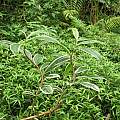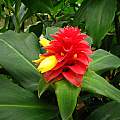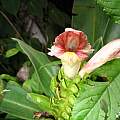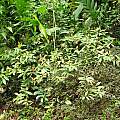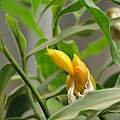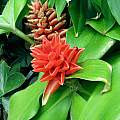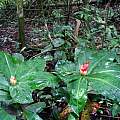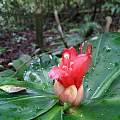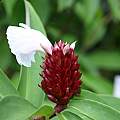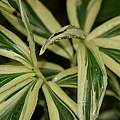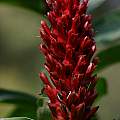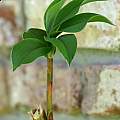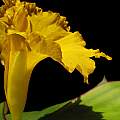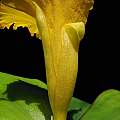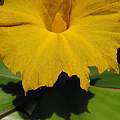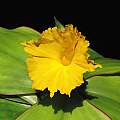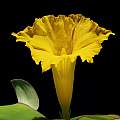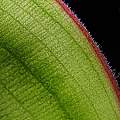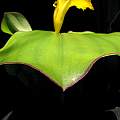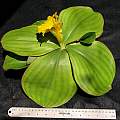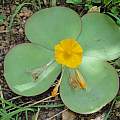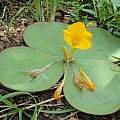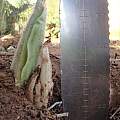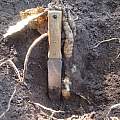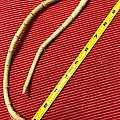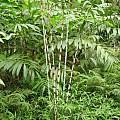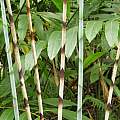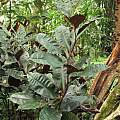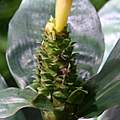Costus is the largest genus of the family Costaceae. There are about 80 species, all of which are tropical. They occur in Asia, Africa, Australia and the Americas. They are characterized by having leaves that grow spirally along a pseudostem. Underground structures are in the form of rhizomes. Plants in this genus are mostly shade-loving, although some species can tolerate sun. They also love moisture, both in the ground and in the air.
Costus amazonicus (Loes.) J.F.Macbr. is native to Peru and Ecuador. This species has a natural variegated form that is very pleasing. Height range: 2-5 ft. Photo by Nhu Nguyen.
Costus barbatus Suess. is native to Costa Rica. Height range: 4-8 ft. Photo by Nhu Nguyen.
Costus guanaiensis Rusby is native from S. Mexico to Tropical America. Height range: 3-4 ft.
Costus guanaiensis spp. macrostrobilus (K.Schum.) Maas is native to Panama. The photo below were taken by Nhu Nguyen in habitat.
Costus lasius Loes. is widespread in Central and South America. It has an a more or less compact form with small pseudostems and leaves which spread out towards the top. The plant can be successfully grown in a 3-5 gallon pot or it can be planted in the ground. In both cases, the plants will grow to only about 4 feet tall. If grown in pots, they will need to be divided as dividing rhizome can break a pot. Both the bracts and flowers are yellow and creates a nice show in a large clump. Photo by Nhu Nguyen.
Costus osae Maas & H.Maas is native to the Osa Peninsula, Costa Rica. The leaves are covered in fine hairs and the undersides are extremely soft because of these hairs. Height range: 3-4 ft. Photo by Nhu Nguyen.
Costus pulverulentus C.Presl is native to Panama. The leaves on this species are extravagantly large and spiral with a central inflorescence. Often it is the only brightly colored plant part in a large patch of forest. Height range: 5-8 ft. Photos taken by Nhu Nguyen of plant in habitat on Barro Colorado Island, Panama 2005.
Costus speciosus (J.Koenig) Sm. is now considered by some authorities to be a synonym for Cheilocostus speciosus (J.Koenig) C.D.Specht and by others as a synonym for Hellenia speciosa (J.Koenig) S.R.Dutta. It has a wide natural distribution from the Himalayas to Indonesia. The most common forms have brick red bracts and white flowers. Though not as cold hardy as the standard, a beautiful large pink flowered form from Java is in cultivation. Height range: 6-10 ft. A beautiful variegated cultivar is commonly grown as well, unfortunately is is not as cold hardy as most other forms. Flower size and plant height are variable. The dwarf cultivar known simply as Tetraploid grows to 3 feet and tends to be a slower grower. Standard forms can easily reach 6 to 10 feet. It can easily be grown from seed, cuttings, and rhizome divisions. Photographs by Tim Chapman.
Costus spectabilis (Fenzl) K.Schum. is a rhizomatous geophyte native to much of tropical Africa: Benin, Burkina Faso, Côte d'Ivoire, Ghana, Guinea, Mali, Nigeria, Senegal, Sierra Leone, Togo, Burundi, Cameroon, Gabon, DRC, Chad, Ethiopia, Sudan, Kenya, Tanzania, Uganda, Angola, Malawi, Zambia, and Zimbabwe. Height range: 3 ft. or more.Most gingers and other zingiberales technically meet the PBS criteria for what constitutes a geophyte, but this species is rather unique for its genus and fits even the most stringent qualifications for this category. It goes completely dormant during the dry winter, retreating back to a centipede-like rhizome that lacks perennial roots. Unlike other Costus, this acaulescent species doesn't form above ground stems. After a dry winter rest, the combination of warmth and water in late spring cause it to pierce through the bare ground, opening beautiful rosettes of round paddle leaves that will appress themselves to the soil once fully formed. The plants are somewhat reminiscent of Massonia or lily pads floating on the surface of the earth. New leaves have an attractive golden sheen, and many clones have gorgeous red ciliate leaf margins. The abaxial leaf surface consists of a spongy white texture, akin to styrofoam. The flowers are brilliant yellow, sort of resembling a squash blossom when fresh and whilst fading, 9 cm wide. The petals are not very conspicuous, however the real showy part of the flower is the large staminodial labellum. The texture is quite soft and thin, with a crisped margin. Perhaps the most delightful floral detail is that it sparkles in sunlight! Surprisingly it is rare in cultivation, at least outside of the African continent.
When grown in a pot, as shown in my pictures, the curious centipede-shaped rhizomes circle the pot causing the rosettes of leaves to grow crowded together instead of spreading out. Last year I grew it outdoors in Upper Mānoa Valley (O'ahu, Hawai'i), a wet montane tropical environment. It grew well but did not bloom. I suspect that this was due to a lack of strong sunlight and heat (other heat-loving geophytes also failed to bloom in this situation i.e. Bessera elegans, Milla magnifica). This year I placed it under a sodium halide light in my indoor orchid vivarium. It received high light (5500fc), 14-hour days, high humidity, air movement, daytime temp 27 °C, night-time temp 20 °C. This is a promising horticultural subject for climates with warm humid summers. Certainly this would be a wonderful garden plant in seasonally dry tropical lowlands such as leeward lowlands of Hawai'i (especially Kona District), extreme S Florida, much of S and SE Asia, Queensland, India, Caribbean, Meso- and S America, Oceania and Africa. It is not hardy outdoors in S California. It should be kept dry in dormancy, so folks in climates with non-tropical winters can simply bring the pots indoors and keep them dry on a shelf or in a box until the following spring. Shallow wide bulb pans are best. I suspect this would grow well as a potted tender perennial in the US South and East Coast.
Photos 1-8 by Uluwehi Knecht.
Photos below by Nicholas Wightman taken near Lilayi, Zambia.
Photo by Luminita Vollmer of roots sent to PBS BX.
Costus stenophyllus Standl. & L.O.Williams is native to Costa Rica and is becoming endangered in the wild. It is also known as Bamboo or Red Snake Ginger because of the bamboo-like appearance of the pseudostem or the red snake-like head of the inflorescence. This species can grow rather tall to about 8 meters. Photos by Nhu Nguyen.
Costus varzearum Maas is a beautiful ornamental species because of the purple undersides of the leaves. Height range: 3-6 ft. Photos by Nhu Nguyen
